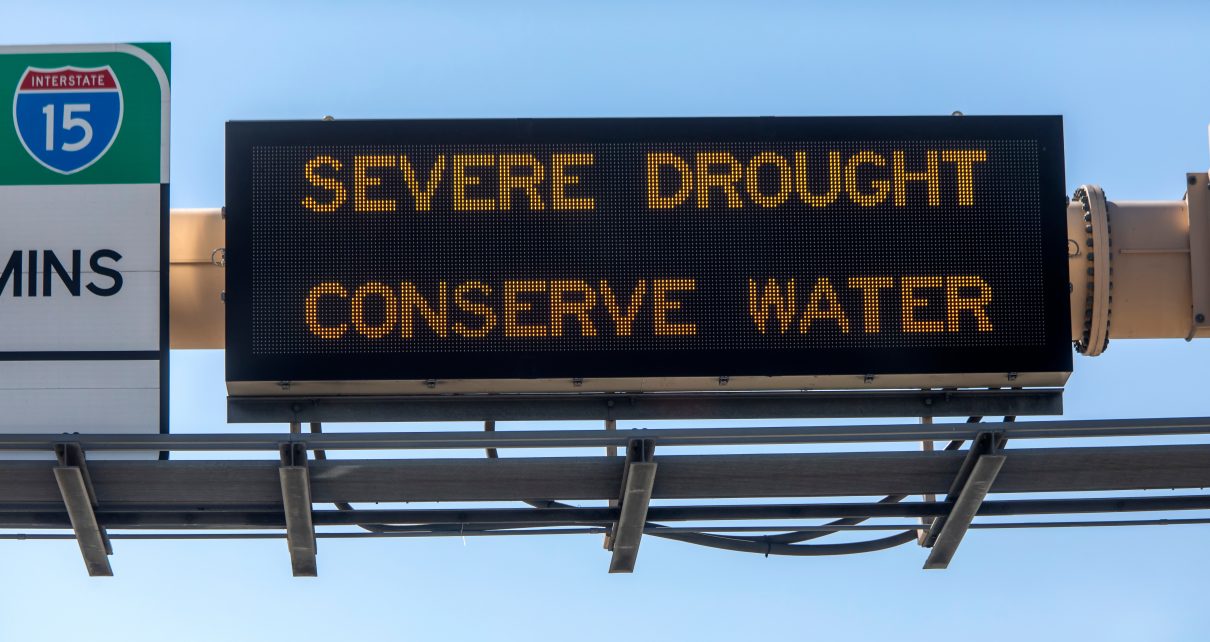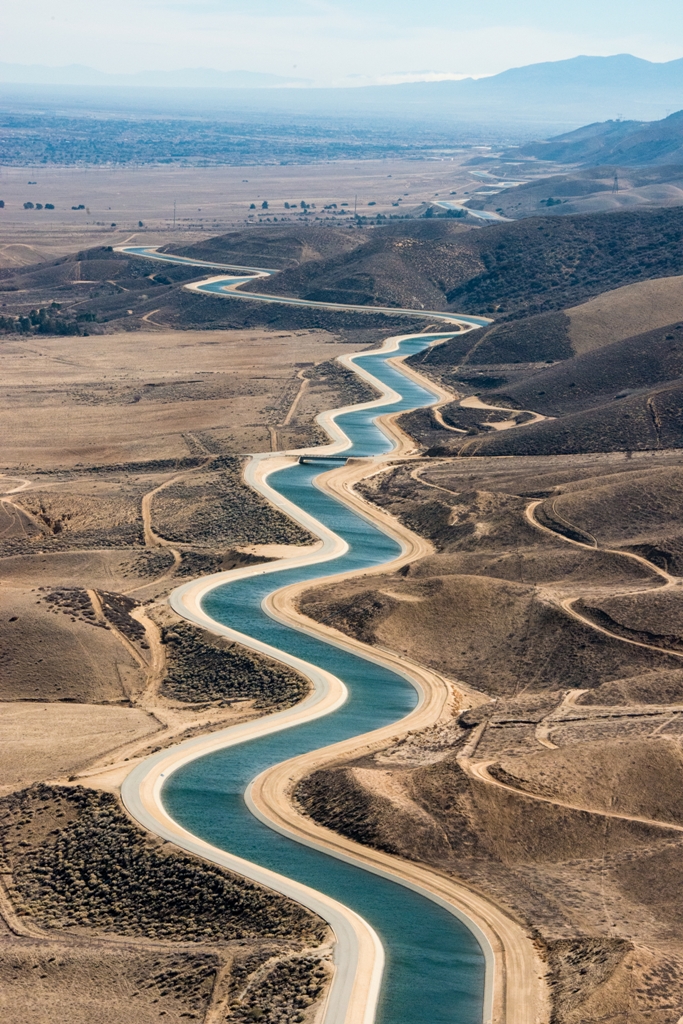
A freeway sign urges residents to conserve water amid a severe drought. (Photo: F Armstrong Photography/Shutterstock)
Desalination: California’s Best Hope To Stave Off Water Restrictions in the Future
Desal plants paired with common sense water usage measures is the best plan for California’s drought
By Evan Symon, May 5, 2022 2:45 am
During the last few years, California’s drought situation has become more and more dire. While a large chunk of it is self-inflicted by the state, as they release an incredible amount of water from dams each year for environmental purposes instead of, you know, agriculture and people, part of it is also that rain and snowpack build have been well below averages in the past. Northern California still has restrictions going on, with Southern California, facing another hot summer, may face a scenario in some areas where water may run out if usage stays as high as it is now.
California isn’t the only state suffering. The majority of Western states are also facing droughts, with some now facing a decision to either release water for people or hold it back in dams to continue to generate electricity. One dam, Glen Canyon, is at such a perilous point that environmentalists are now clamoring to have it torn down again to return the area to its original beauty before it was constructed. Many are horrified at that scenario, especially New Mexico and Utah, which rely on electricity and tourism. But many states down the river, especially those relying on electricity from the Hoover Dam and states like California relying on that water, stand to benefit.
But that just shows how bad it is for everyone. At this point, the U.S. Government has to decide who to screw over.
For decades, we have known about the water issues and many proposals have been offered to redesign dams, destroy dams, shift grass heavy properties to more natural sustainable vegetation, and other similar ideas. While some have worked to some degree, as have common sense water restrictions, it’s not nearly enough and something big needs to come.
The most promising solution has been desalinization, or making seawater drinkable. While there are currently 12 such plants in California, including the large Carlsbad plant in San Diego County, they are currently only making a dent in the states water needs. For a state like California, more desal plants are needed. The problem is, the California Coastal Commission (CCC), backed by environmental groups, have been putting the brakes on many of these projects. The most notable, in Huntington Beach, was denied just last month mostly due to environmental issues.
And look, we get it. The environment in California is delicate, but there needs to be a workable solution here. Where I grew up in Cleveland Ohio, we had our own environmental hazard. It was called the Cuyahoga River (along with Lake Erie, but that one is another story), and we somehow made water on the river catch on fire due to the pollution well through the 20th century. Even when I went to school in the area in the 90’s and 2000’s, well into it being restored to it’s original grandeur, the river catching on fire in the 50s and 60s was still one of the many, many barbs people outside the area would throw at us. But we always pointed out how there was a problem with the water and we fixed it. Same thing with Flint and their water problems with lead in more recent years. Problem, work it out, solution. And the result – the water is now drinkable once again.
California’s drought is a different kind of problem of course, but it still relies on more than just work arounds – it needs a firm solution. Or, at the very least, something to lessen the effects of the drought while other solutions are found. Cleveland, Flint, and so many other Eastern cities found solutions for pollution and got their fresh water back. California needs one for drought. And desalination is the best one after having natural rain and snowpack increases come out of the blue.
The need for more desalinization plants in California
“Huntington Beach alone, the plant there, would bring in 50 million gallons of freshwater a day,” said Alonzo Taylor-Morgan, a water control specialist, to the Globe on Wednesday. “LA alone uses 524 million gallons a day. One plant alone won’t solve that. But get a bunch around the coast and team it up with common sense water usage? We’re not talking about putting a dent, singular, in there. Get in a bunch going down the coast, maybe even look at other sources like the Salton Sea for this, and you have a real workable solution in place.”
“When the snow pack comes back and we get out of the drought, then we work on refilling reservoirs with this water and find other viable storage techniques when, not if, a major drought comes back. That’s the smart solution.”
“Oh, and these plants? We’re talking about a lot of jobs on everything from engineers to maintenance to environmental monitors. Not to mention construction, and in the case of the Salton Sea, bringing jobs to needed places. And who knows what technology can bring us. Maybe some offshore oil platforms scheduled to go down in the coming years can be refitted for these plants. Yeah, bit of a stretch now of course, but who knows what the future can bring.”
“Desalinization is by far the best option we have though combined with reasonable restrictions during drought years. But so many people don’t want to hear it because they think it can be environmentally damaging, even though they really aren’t. California needs to make some hard choices coming up, but desalinization shouldn’t even be a choice. It should be a need, at least where we stand now.”
- Man Who Broke Into L.A. Mayor’s Home to Receive Probation, Mandatory Drug Treatment - July 25, 2024
- California National Guard Counterdrug Task Force Seizes nearly $4 Million Worth Of Fentanyl In June Following Ramping Up Of Actions - July 24, 2024
- San Francisco’s Guaranteed Income Programs for Trans People to End - July 24, 2024





I disagree that CA is suffering from severe drought; CA is suffering from ignorant politicians and “environmentalists” who send 80% of our fresh water to the Pacific Ocean. It’s a mystery to me why they would do this while yelling about “Climate Change” and the seas rising. If more water storage was built, water could be stored in rainy/snowy years, but they fight that at every turn, and even tear down existing dams. It’s the definition of insanity!
Why is nobody discussing primary water. PrimaryWater.org
Oh because they don’t want us to know? Get the information out to farmers and land owners, please!! Our ignorant officials, probably not elected, thought it was important to let the water run into the Pacific Ocean to save the salmon. How stupid. Whomever it is, but these fires are done one purpose and for the most part causing the most horrific damages. After that property owners have trouble getting insurance so they have to.sell. Probably Gates of Hell buying it up with his buddies to take over more land to produce more gmo fake foods. What a scam and shamful.state we are in. We better have some good people to run this state or it will be worse than the current situation. The problems here are beyond belief and if not solved in some kind of way, more of us will move!!
The population of California along with the far west states have out grown the supply of water, period. Historical accounts & data illustrate droughts are nothing new. 1842-43 John Sutter writes of little on no rain to support crops. In the 1920 N. California & Oregon faced a limited supply of water to the point certain growing regions referred to the period as a famine. Before Shasta Dam was built you could walk across the Sacramento River in October & not get your knees wet. Also, read Cadillac Desert. De-Sal takes a tremendous amount of power, with our current delusional plan to jettison natural gas & etc, How’s going to power these plants.
That would be a huge YES for desalination. Israel has developed their desalination technology to the point where they are generating so much fresh water that they are looking all over the Middle East for people to send their surplus to.
But first, we have to deal with the problem of the environmental extremists, and the activist judges who promote their agenda. Life is a competition. Species that adapt well to a changing environment survive and thrive. Those which don’t adapt well disappear. Over the 3+ billion years since life first appeared on this planet, millions of species have dominated their environment for a time, then faded into oblivion. Not one of the species that we have here today (including humanity) will still be around 50 or 60 million years in the future. Try as we might, we can’t keep that from happening. Despite heroic, superhuman efforts, the White Rhino is gone forever. Other species will follow.
This doesn’t mean that we should trash our environment, because it’s all going to burn someday. Noblesse oblige. It is incumbent on mankind to manage the resources of this planet intelligently, because we are the only ones who can. But there has to be a rational recognition that species with tiny populations are failing at their task of competing for habitat. To put the lives and livelihoods of millions of people at risk for the sake of protecting an unviable evolutionary dead-end is irresponsible. Similarly, to insist on preserving all of “nature” in its original state, untouched by the hand of man, at the expense of meeting human needs, is an incredibly selfish and quite indefensible position.
The population of California will continue to grow – especially if the extreme left has its way and continues to promote untrammeled migration across our Southern border. The growing population will need a growing water supply. Like it or not, there just is never going to be enough rainwater and snow pack to support both a million new Californians AND the snail darter. Sacramento is going to have to make a tough decision which one they will give up.
Meanwhile, what else can we do?
Desal, yes. But let’s also look at what we do with our storm water run-off. If, instead of sending out to the ocean, loaded as it is with highway pollution, we dumped it into the played-out oil wells across the coastal plain, it could then be economically cleaned up and delivered to the farmers of the central valley for irrigation, or to industry where the quality of the water is less important than the quantity.
And we could invest in salt water infrastructure. as long ago as 1980, Catalina Island had dual water systems. The toilets on the island were flushed with salt water. Imagine setting up a similar system on the mainland. How long would it be before a flourishing home desalination plant business sprang up? If sea water were coming to your home, priced far below fresh water, how many people would be figuring out creative ways to use salt water instead of fresh?
One final thought. Only 15% of California water consumption is for domestic use. So why is it that whenever someone announces a drought, it is the domestic users who have to bear the burden of draconian restrictions?
^^^ Great, thoughtful response….
Unless our “Young Global Leader” is executing his plan to break the economy for Herr Schwab’s “Great Reset” and “Build Back Better” New World Order, or the ChiComs want the Central Valley to grow food for their populace…..